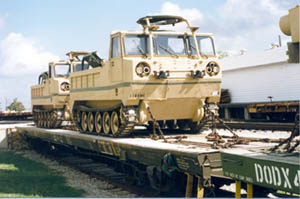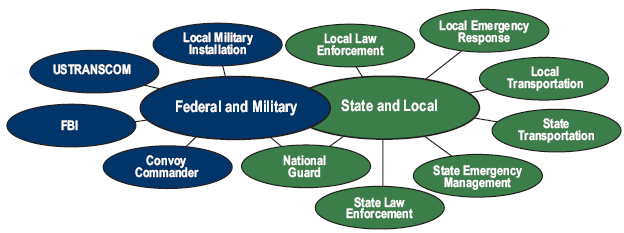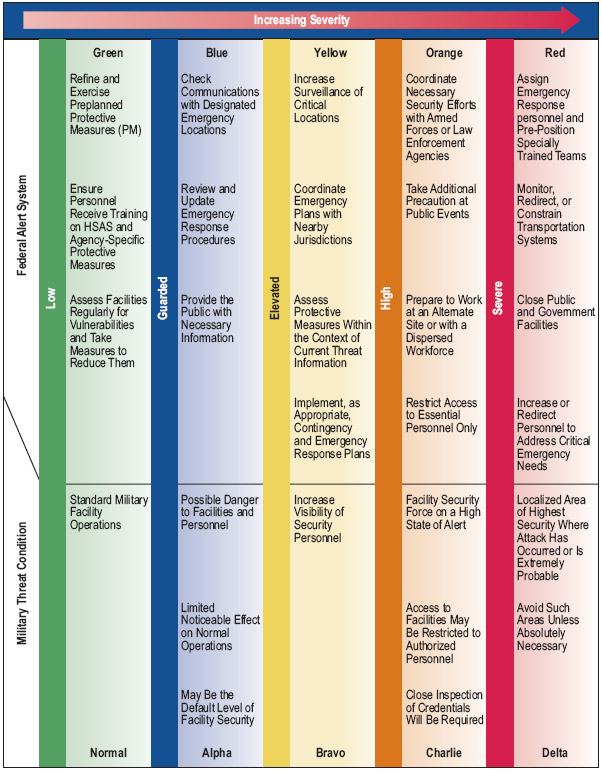Coordinating Military Deployments on Roads and Highways:
A Guide for State and Local Agencies
This publication is an archived publication and may contain dated technical, contact, and link information.
Chapter 1. Introduction to Current Military Deployment Concepts
The U.S. military has changed significantly to meet the challenges of our uncertain world. An understanding of the evolving international environment, the national security strategy, and the capabilities required for full-spectrum dominance have guided the military's transformation from a forward-deployed Cold War force to a capabilities-based, power-projection force located largely in the United States. The military has reduced its size, redistributed its forces, closed and realigned bases, reorganized its overseas equipment prepositioned, and improved active and reserve component integration to become leaner, more versatile, and more deployable.
Increased deployment activity has become the normal operational standard within the continental United States, which may regularly affect the planning and operations for State Departments of Transportation (SDOT). As a consequence, all States are experiencing increased cross-State movements of military assets with destinations beyond State borders. Within a State with major military installations, such as those with power projection platforms (PPP), current deployment strategies may require 24x7 operations with enhanced security for increased equipment and personnel movements.
This chapter provides a broad overview of current military doctrine and policies relevant to military deployments on public roads. The range of size and scope for deployments is discussed, including preferred travel modes and recent lessons learned. The major agencies and organizations are introduced, with greater definition of roles and responsibilities to be examined in chapter 2. Finally, the role of advisory systems and implications for military deployment are presented.[1]
Current Military Deployment Strategy
Strategic mobility and readiness are keys to the military’s ability to project power worldwide. Each of the military services—Army, Navy, Air Force, and Marine Corps, as well as their component Reserve, National Guard, and Coast Guard counterparts—has made great strides in implementing the specific recommendations of the congressionally mandated 2001 Mobility Requirements Study and more recent findings from Operations Enduring Freedom (OEF) and Iraqi Freedom (OIF) as well as the Global War on Terrorism (GWOT).
The ability to deploy equipment and personnel rapidly is an imperative of the national military strategy. That strategy expects the military to defend the homeland, deter aggression in four regions of the world, swiftly defeat adversaries in two other conflicts, and conduct a limited number of small operations. Implied in these missions is the requirement to deploy forces within the United States and from the United States to anywhere in the world.
To assist the military services in their planning and better prepare for future operations, the Department of Defense has established an objective of being able to deploy to a theater within 10 days sufficient combat power to defeat an enemy during the next 30 days and be ready for the next fight within another 30 days. Key to meeting these deployment goals is the capability of units to move rapidly from their installations to land, sea, and aerial ports of embarkation or to designated locations within the United States.
Military units use various methods to move equipment and personnel to seaports. Heavy equipment usually will be shipped by rail; however, some equipment must be deployed on public roads, either driven by military personnel or consigned to commercial carriers, to arrive at the seaport on specific dates and times for loading onto ships. When the military uses public roads, it organizes the equipment into convoys for control and protection. Appendix B provides detailed information about the military's organization of convoys and standard highway procedures for convoys.
Insights from OIF highlight the dynamic and changing nature of military deployment needs. During the spring of 2003, shipment volumes of military assets from military installations through the nation to strategic seaports increased 29 percent. This increase created a 15 percent increase in required truck capacity just for military needs.[2] For certain States with destination ports, the increase in truck volume was greater than 15 percent because vehicles were traveling from multiple States to a designated port within a State. Consequently, some States with PPPs became concerned about regional and local roadway congestion and extended hours of operation involving greater than average volumes.
Rail carriers experienced similar volume increases. While most rail carriers accommodated the increased demand for their services between military installations (with rail connections) and ports, logistical and operational issues in selected regions of the country prevented certain equipment from moving by rail. For example, some military installations did not have rail accessibility but needed to move assets. Also, the special rail cars used for transporting military assets ("X-cars") were not always available in convenient locations, creating additional shortfalls in rail capacity. Figure 1 illustrates a typical use of DoD X-cars. While rail operations were generally successful, operational and capacity shortfalls required truck carriers to complete the deployment mission, resulting in the addition of commercial carriers on the public roadways.

Figure 1. DOD Uses Special Heavy Equipment Railcars Known as DODX Cars
Industry, government, and military leaders have discussed and prioritized planning and operational lessons learned for all transportation modes. Their recommendations sometimes apply to specific sectors, such as maritime, air, rail, or highway. Others recommendation call for appropriate and updated coordination among several agencies or sectors. This guide has been developed to help address one of these key coordination areas—military deployments—which require the use of public highways. As one State Department of Transportation chief engineer indicated, he wanted to make sure that he was doing everything possible to ensure safe and efficient military deployments—not cause any delays or unsafe travel on the public roadways.
Deployment Coordination and Communication
A variety of Federal, State, regional, and local agencies as well as commercial firms are involved in moving military assets on public roads. Figure 2 depicts the Federal and State agencies that are normally involved in military deployments on public roads.

Figure 2. A Variety of Organizations Are Essential to Effective Military Deployment Operations
In general, the military defines its own deployment needs. The military coordinates these needs with local military installations, commercial carriers, and State and local agencies, as appropriate. The response by State and local agencies requires an understanding of military coordination and communication protocols. Subsequent chapters will provide greater detail on these roles, responsibilities, and interaction points.
The SDOT is primarily responsible for planning, operations, and maintenance of public roads; the State Department of Public Safety (SDPS) works with transportation agencies (State, city, and local) to maintain and enforce public safety on roadways. During certain military deployments, public safety agencies may assist through normal procedures and protocols; however, under special circumstances, the military may need enhanced assistance from the SDOT and SDPS. These special circumstances are discussed in greater detail in chapters 3 and 5.
Federal and Military Threat Levels and Advisory Systems
Many agencies are building response plans around threat level and advisory systems. At the time of publication, the Department of Defense (DoD) and the Department of Homeland Security (DHS) use two separate but similar advisory systems that fulfill vital and specific requirements for a variety of situations. The Homeland Security Advisory System (HSAS) provides a national framework for these systems, allowing government officials and citizens to communicate the nature and degree of terrorist threats by characterizing appropriate levels of vigilance and readiness in a series of graduated threat levels. The protective measures that correspond to each threat level will help the government and citizens decide what action to take to help counter and respond to terrorist activity. Figure 3 provides an illustration of the HSAS advisory system and compares it to the standard DoD advisory system. The two agencies are working to reconcile and confirm the consistency and response for each level.

Figure 3. A Comparison of the Current Federal Alert System and the Military's Threat Condition System
This guide assumes that military deployments are activated during threat-level conditions of low (green) to elevated (yellow). More extreme national security situations or emergencies (orange or red) will require enhanced coordination and communications, which this guide does not address. State agency responses to such large-scale events may be found in State Emergency Response or Emergency Management Plans.
- As is typical in military discussion, numerous abbreviations are employed. Appendix C provides a list of key terms and definitions relevant to military deployments on public roads. Appendix D provides a list of acronyms used in this document.
- Transportation Research News, March–April 2004, pp. 6–10.